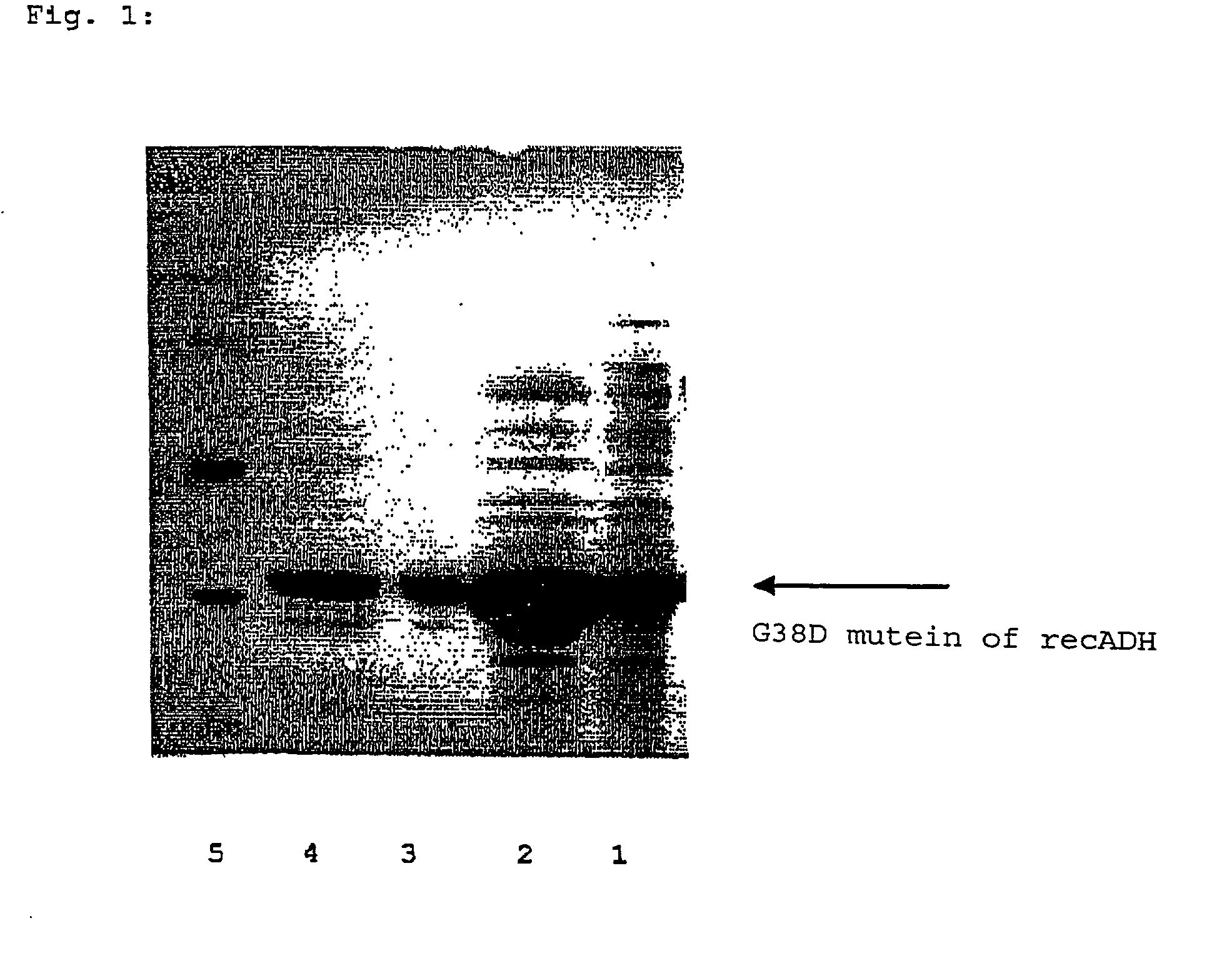Recombinant enzymes having improved NAD (H) affinity
a technology of recombinant enzymes and affinity, which is applied in the field of recombinant enzymes having improved nad (h) affinity, can solve the problems of significantly more unstable coenzyme, more expensive than other drugs, and less value for practical application
- Summary
- Abstract
- Description
- Claims
- Application Information
AI Technical Summary
Problems solved by technology
Method used
Image
Examples
example 1
Description of Preparation of the Mutant recADHG38D:
[0047] The template used for preparation of this mutant was the gene of the wild-type enzyme present as a clone in E. coli.
[0048] Starting from the primary sequence of the wild-type enzyme, and taking into consideration the knowledge of the spatial structure of this wild-type ADH, genetic primers were defined and used in such a way that a replacement of glycine by aspartic acid was performed at position 38 with the "polymerase chain reaction" method (PCR).
[0049] Primers for the directed mutagenesis of the change of cofactor specificity from NADP to NAD (the desired amino acid replacement is indicated in bold italics):
[0050] 5'-Primer with the G38Ds amino acid replacement:
1 5'ACC GAC CGG CAC AGC GAT GTT GGT 3' (SEQ ID NO 3) T D R H S D V G (SEQ ID NO:4)
[0051] 3'-Primer with the G38Das amino acid replacement:
2 5'-ACC AAC ATC GCT GTG CCG GTC GGT 3' (SEQ ID NO:5) G V D S H R D T (SEQ ID NO:6)
[0052] In order to perform a mutation succes...
example 2
Purification and Biochemical Characterization of the Mutant recADHG38D
[0065] The mutein was purified to almost homogeneous protein and characterized.
[0066] Purification of G38D Mutein of recADH:
[0067] The E. coli strain containing the mutein was digested with 0.1 M Na acetate of pH 4.5 (glass-beads digestion, IMA disintegrator S, 4000 rpm, 20 minutes, 4.degree. C.) and the cell slurry was then centrifuged at 13000 rpm (Sorvall SS34 rotor, 4.degree. C., 10 minutes). The cell-free supernatant contains the enzyme (raw extract). This raw extract was adjusted to 0.6 M with (NH.sub.4).sub.2SO.sub.4 and applied on a phenylsepharose column (25 ml SV, Pharmacia) equilibrated with 50 mM TEA of pH 7.0+0.6 M ammonium sulfate+1 MM MgCl.sub.2. The protein was eluted with salt gradient decreasing to 0 M ammonium sulfate. The active fractions were united and concentrated by ultrafiltration (Amicon stirred cell). Ammonium sulfate up to 1.2 M was added to this active pool, whereupon the mixture was a...
example 3
Comparison of the Biochemical Properties of the Mutant recADHG38D with a Mutant Prepared Per WO99 / 47684 and with the Wild-Type Enzyme
[0087] The Km values and all data related to Km or Vmax values are presented in the following overall table; the calculation of the values was performed by means of nonlinear regression with the program ORIGIN.
8TABLE Summary and comparison of all characteristics of the G38D mutein and mutant 2 (W099 / 47684) with the wild-type enzyme Wild-type Characteristics enzyme Mutant 2 G38D mutein pH optimum for 6.5 6.5 5.5 reduction pH optimum for 8.0 6.5 6.5 oxidation pH for 24 hours 4.5-9.0 (70%) 5.5-8.5 (70%) 6.5-8.5 (80%) stability Temperature 55 50 40 optimum [.degree. C.] Thermal stability at 150 h* 16.5 h 148 h* 30.degree. C. Thermal stability at 7.15 h* 0.19 h 257 h* 42.degree. C. Km NAD [mM] 2.94 0.77 0.89 Km NADP [mM] 0.24 0.11 14.04 Vmax NAD 467 439 236 [nMol / ml*s] Vmax NADP 1420 623 402 [nMol / ml*s] kcat NAD [s.sup.-1] 21.4 33.11 34.57 kcat NADP [s.sup....
PUM
| Property | Measurement | Unit |
|---|---|---|
| Temperature | aaaaa | aaaaa |
| Molar density | aaaaa | aaaaa |
| Volume | aaaaa | aaaaa |
Abstract
Description
Claims
Application Information
 Login to View More
Login to View More - R&D
- Intellectual Property
- Life Sciences
- Materials
- Tech Scout
- Unparalleled Data Quality
- Higher Quality Content
- 60% Fewer Hallucinations
Browse by: Latest US Patents, China's latest patents, Technical Efficacy Thesaurus, Application Domain, Technology Topic, Popular Technical Reports.
© 2025 PatSnap. All rights reserved.Legal|Privacy policy|Modern Slavery Act Transparency Statement|Sitemap|About US| Contact US: help@patsnap.com



